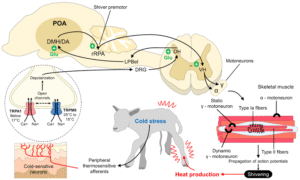Back to: ZOOLOGY 400 Level
Welcome to class!
Hello, my bright star! I’m so happy to have you here today. Every time you join class, you’re making a strong step toward understanding your amazing body. Today, we’ll talk about Metabolic Rate and Thermogenesis — how your body uses energy and stays warm, even when the weather is cold or you haven’t eaten in hours. This is something that happens quietly inside you every single moment, and knowing about it helps you care for your health and energy better.
Metabolic Rate And Thermogenesis
Metabolic Rate
Your metabolic rate is the speed at which your body uses energy (calories) to perform all its functions — like breathing, pumping blood, digesting food, or simply keeping you alive while you’re resting.
There are different types:
Basal Metabolic Rate (BMR): This is the amount of energy your body uses when you’re at rest — not doing anything at all. Even if you lie down all day, your body still needs energy to keep your heart beating and lungs breathing.

Resting Metabolic Rate (RMR): Similar to BMR, but includes slight movement like sitting up or talking.
Active Metabolic Rate: This includes the energy used when you walk, run, dance, or do anything physical.
Example: Imagine a generator that runs even when nothing is plugged in — just to stay on. That’s how your body uses energy at rest.
Factors That Affect Metabolic Rate
Your metabolic rate depends on:
Age – It slows down as you grow older.
Muscle Mass – More muscles mean higher metabolic rate.
Gender – Men usually have a slightly higher rate than women because of more muscle.
Genetics – Some people naturally burn energy faster.
Hormones – Like those from the thyroid gland (thyroxine) that increase energy use.
Thermogenesis
Thermogenesis is the process where your body produces heat — especially when it burns food or fat. It’s part of your metabolism and helps regulate your body temperature.
Types include:
Obligatory Thermogenesis – Happens naturally during digestion and metabolism.
Adaptive Thermogenesis – Happens when the body needs to produce extra heat — like in cold weather or after eating spicy food.

Example: When you eat pepper soup and feel hot, your body is doing adaptive thermogenesis.
Why It Matters
Understanding your metabolic rate and thermogenesis helps you make better lifestyle choices — like eating right, staying active, and managing stress. If your body burns energy well, it helps prevent weight gain, fatigue, and some health problems.
Summary
- Metabolic rate is the speed at which the body uses energy for life processes.
- BMR is the energy needed at complete rest, while active metabolism includes movement.
- Factors like age, gender, muscle mass, and hormones affect metabolic rate.
- Thermogenesis is the heat production during metabolism.
- It helps maintain body temperature and burn calories, especially after eating or in cold.
Evaluation
- What is metabolic rate?
- Differentiate between BMR and active metabolic rate.
- List three factors that affect metabolic rate.
- What is thermogenesis, and when does it happen?
- Give an example of adaptive thermogenesis in real life.
You’re doing an amazing job! Every bit of knowledge you’re gaining is helping you understand your body better. You are sharp, capable, and on a brilliant journey with Afrilearn by your side. Keep going — your dreams are within reach and your brilliance shines every day!
